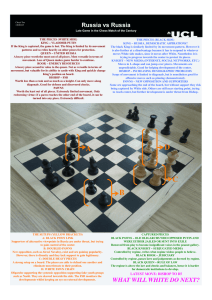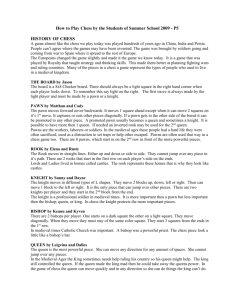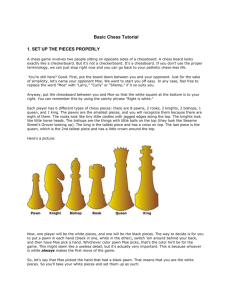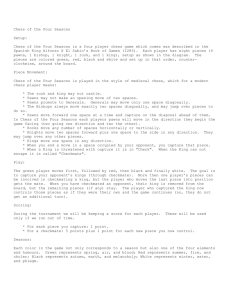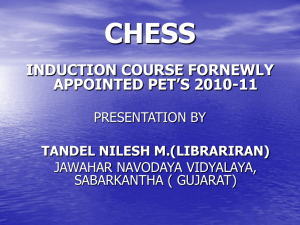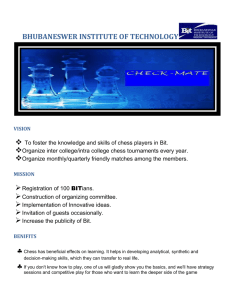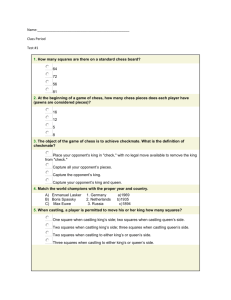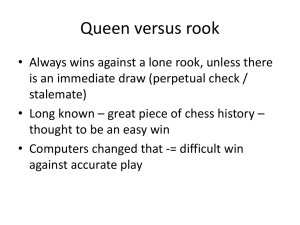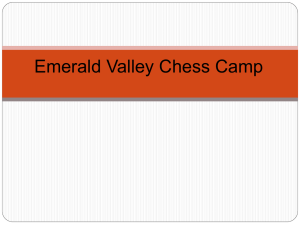How to Play Chess - Sites at Penn State
advertisement
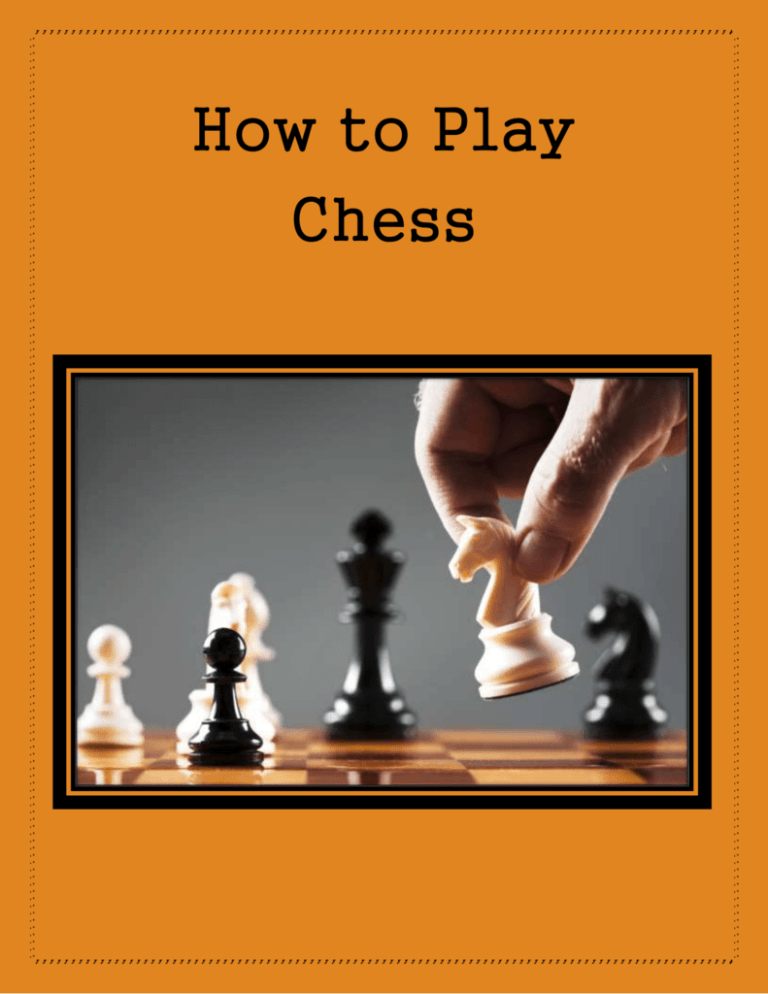
How to Play Chess Introduction People have been enjoying chess for over 1,500 years and it’s only becoming more popular. Many people want to start playing but are intimidated by the seemingly insurmountable task of learning the pieces and gameplay. This guide will explain each of the pieces, how they move, setting up the board, and a basic strategy that new players can follow. 1. Know the Pieces Figure 1 There are six unique pieces that are involved in chess: Pawn, Rook, Knight, Bishop, Queen, and King. Figure 1 shows examples of what each of these pieces can look like. However, the exact shape of the pieces will vary from set to set. Each of these pieces moves in a different way and each can be useful in a variety of different situations. Piece Description Pawn – Pawns are the weakest pieces on the chessboard, but they are the most plentiful. At the beginning of the game, each player has eight pawns. These pieces can only ever move forward. The first time a pawn is moved, it can move one or two squares straight forward. After this initial move, pawns may only move one space forward at a time. Pawns may not take an opposing piece by moving straight ahead. Instead, they can only capture by moving one space diagonally forward. Pawns are only permitted to move this way if it is to take a piece. Knight – When moving a knight, it must move in an “L” shape. This is done by moving two squares in one direction, then moving one square in another direction. Knights are unique in that they are the only piece that may move through other pieces. Rook – Rooks may move as many spaces as desired, but only in straight lines. Although they can move across the entire board, taking a piece forces a Rook to end its move. Bishops – Like rooks, Bishops can move the entire length of the board if necessary. However, bishops may only move diagonally. In other words, if a bishop starts on one color of square, it can never leave that color. Queen – As the most powerful piece, queens may move any number of spaces in any one direction. The Queen’s movement options include the combination of any possible moves for a Bishop and any possible moves for a Rook. King – Even though the queen is the most powerful piece, the king is the most important piece. The King’s movement is limited to one square in any direction. If the King is lost, the game is over. Figure 2 2. Learn How to Set Up the Board To prepare the board for a new game of chess, position the board with the black A1 square to the white player’s left. Then, place the pieces on the board as shown in Figure 3. The eight Pawns are placed along the entire 2nd row for the white player and 7th row for the black player. Rooks go on the ends of the row closest to you. On the inside of each Rook, put a Knight. Bishops are placed on rows C and F, inside of the Knights. The King goes on E and the Queen on D. Figure 3 3. Understand the Objective Players take turns moving one piece at a time with the white player making the first move. Unlike Checkers, in Chess only one piece needs to be captured for the game to be over: The King. Any time the King is in danger of being taken on the next turn, “Check” is called. This term means that the player who’s King is at risk must move in such a way that the king is protected again. This can be done by moving the King to safety, moving a piece between the King and the attacking piece, or taking the opponent’s attacking piece. To take an opposing piece, move one of your pieces to occupy a square that is presently occupied by an opponent’s. If a player’s King is put into a position where it is in danger and no move can be made to protect it, Checkmate is called. When a player is put in Checkmate, the game is over. 4. Know the Special Rules Chess has several rules that aren’t apparent, even through an understanding of the other elements of the game. These moves include Castling, En Passant, and promoting pawns. Castle - This must be the first move for your King and whichever of the two Rooks you decide to use. There must also be no pieces in between the King and the Rook and this move must not put your King in Check. Castling means moving the King two spaces towards the Rook, then move the Rook directly to the opposite side of the King. En Passant - This is a French move that keeps a pawn from using its first move of two squares to escape an otherwise inevitable capture. An example of this is shown in Figure 4. Promotion - When a Pawn successfully makes it across the board to the furthest row from you, it gets promoted. Promotion allows you to exchange your pawn for a Knight, Bishop, Rook, or Queen. 5. Figure 4 Have a Strong Opening The conventional strategy is to move either the E or D pawns first, as these moves give you more options for the next few turns. Unless it’s absolutely necessary, avoid moving the same piece more than once in the beginning of the game. Focus on getting multiple pieces involved as early as possible. Spend the early game trying to control the center of the board. The better you do this, the easier it will be to transition into the later parts of the game. 6. Learn to Evaluate the Board As the game progresses from the openings, evaluating the board becomes increasingly relevant. When thinking about a move, it’s important to take into consideration a few things: Plan ahead – Make sure to think about what you want to accomplish in the next few turns. Target you opponent’s piece or plan to take control of a specific area of the board. Having short and long term goals while playing will increase the effectiveness of your moves. Know how to trade – Knowing how to value your pieces Piece Value compared to your opponent’s pieces is tricky. As a Pawn 1 general guideline to follow, each piece has a point Knight 3 value associated with it called the Reinfeld Value. Bishop 3 These values are shown in Figure 5. Keep in mind that Rook 5 the Reinfeld Value is not a strict rule to follow; it Queen 9 King ∞ merely offers a point of reference. Consider your opponent’s moves – Try to think about Figure 5 what your opponent might be planning. Even if his/her move doesn’t endanger any of your pieces this turn, they may be attempting to set up an attack next turn. If your opponent moves in a way that endangers one of his/her own pieces, consider the possibility that it’s a trap. Figure 6 7. Use Your Pieces Effectively In order to maintain an effective board state, you’ll need to try to keep your pieces in positions where they have the most power. Due to each piece moving differently, each piece is more useful when positioned in different ways. It is also important to involve all of your pieces in your game plan. Pawns – Pawns are the most powerful in a straight line across a row. Avoid breaking this formation unless there is a significant advantage for doing so, as individual Pawns are much less powerful once separated from the group. Knights – Despite the fact that a Knight’s range is limited, it is often one of the hardest pieces to defend against due to the number of possible moves it has. Try to avoid putting your Knight on the edge of the board, as this position lowers the number of potential moves for your piece. Remember this rhyme: “If the Knight’s on the rim, things are getting grim.” Bishop – Bishops are the most threatening while on one of the center diagonals. From here, they control the most space. Be cautious of your opponent blocking your Bishop’s diagonal with Pawns, as this will severely limit your piece’s impact. Rook – By positioning a Rook along a row or column that doesn’t contain any pawns, you’ll maximize its effectiveness. Even though Rooks can be difficult to get involved in the early game, they’re some of the most potent Checkmating pieces. Queen – Due to the Queen’s freedom to move in any direction, it is most powerful in the center of the board. Keep in mind that this position also exposes your Queen to potential attacks, so it is best to keep your Queen one move away from center. By doing this, you can keep your Queen safe and still move it to a relevant square when need be. King – The King is the most important piece on the board. It can only move one square at a time, so it can be difficult to move to safety. However, the King is easily protected from attacks by blocking with less valuable pieces. 8. Practice The last step to learning how to play Chess is to practice. There is only so much that can be learned from reading guides. The best way to become a better Chess player is to play regularly. Here are some key points to try while practicing: Try new openers – Experiment with different beginning strategies and try to determine which one works best for your play style. Play against different opponents – Each person that you play against will teach you something new about the game of Chess. Try to play against as many people as possible. Don’t be afraid to lose – In Chess, losing teaches you more than winning. Never be upset with yourself after a loss. As long as you learned something from the game, then it was successful. Ask for advice – After a game with someone, ask them about his/her strategy or if he/she saw any specific areas of weakness in your play. This is doubly beneficial, as it will help you improve your strategy and it will give you insight as to how other players think. Figure 7 Sources Introduction Picture – www.westerlylibrary.org Figure 1 – www.chess-game-strategies.com Figure 2 – www.chesscountry.com Figure 3 –www.soyouwanna.com Figure 4 – www.wikipedia.org Figure 6 – www.techegeek.com Figure 7 – www.wikipedia.org
